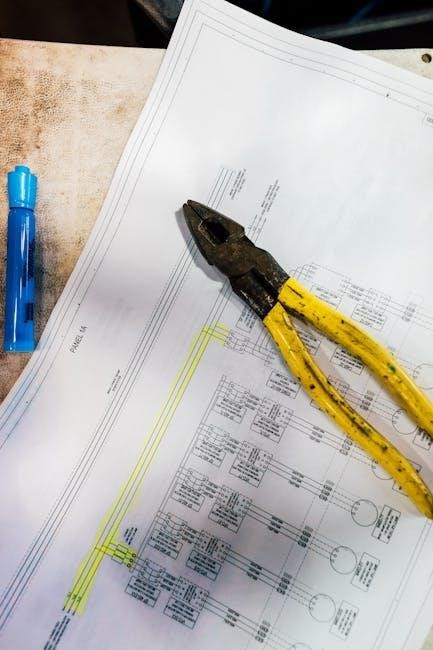Snap Circuits Jr. Manual: A Comprehensive Guide
The Snap Circuits Jr. manual serves as an indispensable resource for young electronics enthusiasts. It provides clear, concise instructions and illustrated diagrams, guiding users through numerous projects; Understanding the manual is crucial for successfully building circuits, troubleshooting issues, and maximizing the educational value of the Snap Circuits Jr. set.
Snap Circuits Jr. is an educational toy designed to introduce children to the exciting world of electronics. This kit utilizes a unique snap-together system, eliminating the need for soldering or tools, making it safe and accessible for young learners. The core principle behind Snap Circuits Jr. is “learning by doing,” allowing children to construct various electronic circuits and experiments through hands-on activities.
The kit includes a variety of components, each mounted on plastic modules with snap connectors. These components range from basic elements like batteries and wires to more complex parts such as switches, LEDs, and speakers. The Snap Circuits Jr. manual serves as a comprehensive guide, providing step-by-step instructions for building over 100 different projects.
These projects cover a wide range of electronic concepts, including series circuits, parallel circuits, and basic electronic functions. Children can learn about electricity, magnetism, and circuit design in an engaging and interactive way. Snap Circuits Jr. is an excellent tool for fostering creativity, problem-solving skills, and an early interest in STEM (Science, Technology, Engineering, and Mathematics) fields. By following the manual and experimenting with the components, children can gain a solid foundation in basic electronics while having fun.
Understanding the Components

To effectively use the Snap Circuits Jr. kit, it’s essential to understand the function of each component. The kit includes various building blocks, each designed for a specific purpose within a circuit. These components are easily identifiable by their labeled modules, which snap together to create functional electronic circuits.
Some of the key components include the battery holder, which provides the power source for the circuits, requiring two AA batteries. Snap wires of different lengths connect the various components, allowing for flexible circuit layouts. Switches, such as slide and press switches, control the flow of electricity, enabling users to turn circuits on and off.
Other components include LEDs (light-emitting diodes) for visual indication, speakers for generating sound, and resistors to control current flow. More advanced components, such as the photoresistor, respond to light, and electronic modules perform specific functions as described in the manual. Each component plays a crucial role, and understanding their individual functions is vital for building and troubleshooting circuits. The manual provides detailed explanations of each component, including its symbol, function, and how it interacts with other parts of the circuit. By familiarizing themselves with these components, users can unlock the full potential of the Snap Circuits Jr. kit.
Battery Requirements and Installation
The Snap Circuits Jr. kit requires a specific type and number of batteries to operate correctly. Each circuit needs a power source, which is provided by the battery holder component. Typically, the kit uses two (2) 1.5V AA batteries. It is essential to use the correct type of batteries, as using incorrect batteries can lead to malfunction or damage to the components.
When installing the batteries, ensure that they are inserted with the correct polarity, matching the “+” and “-” symbols inside the battery holder. Incorrect battery installation can prevent the circuit from functioning and may potentially damage the components. The battery holder is usually the first component you will use in each project, as it provides the necessary power to run the circuit.

To install the batteries, open the battery holder compartment, insert the batteries according to the polarity markings, and securely close the compartment. Always ensure that the batteries are properly seated and the compartment is fully closed before attempting to operate any circuits. It is also recommended to remove the batteries when the kit is not in use for extended periods to prevent battery leakage and corrosion, which can damage the battery holder and other components. Refer to the instruction manual for detailed diagrams and instructions on battery installation.
Basic Circuit Building Principles
Understanding basic circuit building principles is essential for successfully using the Snap Circuits Jr. kit. A circuit is a closed loop that allows electricity to flow from a power source, through various components, and back to the power source. This flow of electricity powers the components and enables them to perform their functions.
One of the fundamental principles is the concept of a series circuit. In a series circuit, components are connected one after another along a single path. If any component in the series circuit fails or the path is broken, the entire circuit will stop functioning. Another important concept is the parallel circuit, where components are connected along multiple paths. In a parallel circuit, if one component fails, the other components can still function because electricity can flow through the alternate paths.
When building circuits with Snap Circuits Jr., it is crucial to ensure that all connections are secure and that the components are arranged according to the project diagram in the instruction manual. Following the correct sequence and placement of components is vital for the circuit to function as intended. Pay close attention to the polarity of components like LEDs and batteries, as incorrect polarity can prevent the circuit from working and may potentially damage the components. By understanding these basic principles, users can effectively build and troubleshoot various circuits with the Snap Circuits Jr. kit.
Following the Instruction Manual
The Snap Circuits Jr. instruction manual is the key to unlocking the full potential of the kit. It provides step-by-step guidance for building a variety of electronic circuits, from simple light circuits to more complex sound and motion projects. Carefully reading and following the instructions is crucial for success.
Each project in the manual includes a detailed diagram illustrating the placement of the Snap Circuits components on the base grid. It’s essential to match the component numbers and orientations in the diagram exactly. Pay close attention to the polarity of components like LEDs and batteries, as incorrect placement can prevent the circuit from working.
The manual also provides explanations of the circuit’s function and the underlying electronic principles. These explanations help users understand how the circuit works and why the components are arranged in a particular way. By understanding the principles, users can troubleshoot common issues, modify the circuits, and even design their own projects. The manual may also include safety precautions and warnings, which should be carefully reviewed before beginning any project. Ignoring these warnings can lead to injury or damage to the components. By diligently following the instruction manual, users can safely and effectively explore the exciting world of electronics with the Snap Circuits Jr. kit.
Troubleshooting Common Issues
Even with careful adherence to the instruction manual, encountering issues while building Snap Circuits Jr. projects is common. Most problems stem from incorrect circuit assembly. The first step is always to double-check that the circuit exactly matches the diagram in the manual, verifying the placement and orientation of each component. Ensure all snaps are securely connected, as loose connections can disrupt the circuit’s flow.
Battery polarity is another frequent culprit. Ensure the batteries are inserted correctly, matching the positive and negative terminals. Weak or depleted batteries can also cause malfunctions. Try replacing them with fresh ones to rule out power issues.
If the circuit still doesn’t work, inspect the components for any visible damage. Check for bent connector pins, cracked plastic housings, or signs of corrosion. If a component is damaged, it may need to be replaced. Another common issue is incorrect switch settings. Double-check that all switches are in the correct position as specified in the project instructions. By systematically checking these common problem areas, most Snap Circuits Jr. issues can be resolved, allowing young builders to continue their electronic explorations.
Safety Precautions and Warnings
When working with Snap Circuits Jr., prioritizing safety is paramount. Always heed the warnings provided in the instruction manual to prevent potential hazards. A critical warning is to NEVER connect Snap Circuits to household electrical outlets, as this poses a severe shock risk.

Supervision by a knowledgeable adult is crucial, especially for younger children. Adults should ensure that circuits are built correctly and that children understand the principles involved. Never leave a circuit unattended while batteries are installed. This prevents accidental activation or tampering.
Avoid using damaged components. Inspect parts for cracks, exposed wires, or other signs of wear. Replace any damaged components immediately. Do not modify the Snap Circuits components in any way, as this could compromise their safety and functionality. Keep the components away from water and other liquids to prevent short circuits and damage. Store the Snap Circuits set in a dry place when not in use. By adhering to these safety precautions and warnings, users can enjoy Snap Circuits Jr. while minimizing the risk of accidents or injuries and maximizing the educational fun.
Advanced Projects and Experimentation
Once you’ve mastered the basic circuits in the Snap Circuits Jr. manual, it’s time to venture into advanced projects and experimentation. This is where the real learning and creativity begin. While the manual provides a solid foundation, don’t be afraid to think outside the box and explore beyond the pre-defined projects.
Consider combining multiple circuits to create more complex systems. For example, you could integrate a light-controlled circuit with a sound-activated circuit. Experiment with different component combinations to observe their effects. What happens if you add a resistor in series with an LED? How does changing the capacitor value affect the timing of a flashing light?
Document your experiments meticulously. Keep a notebook to record your circuit diagrams, component values, and observations. This will help you track your progress and understand the underlying principles. Furthermore, you can explore online resources for inspiration and guidance, but always prioritize safety and ensure that your experiments are age-appropriate. Remember, the goal is to foster a deeper understanding of electronics through hands-on exploration and discovery.
DOs and DON’Ts of Building Circuits
When working with Snap Circuits Jr., adhering to certain DOs and DON’Ts is crucial for safety and successful circuit building. DO always begin by carefully reading and understanding the instructions for each project. DO double-check that all components are correctly connected according to the circuit diagram before applying power. DO ensure that the battery pack has fresh batteries and is properly connected; DO keep your workspace clean and organized to prevent accidental damage or loss of parts.
Conversely, DON’T ever connect Snap Circuits to household electrical outlets or other high-voltage sources. This poses a severe shock hazard. DON’T modify or tamper with the components in any way. DON’T force the snaps together; if they don’t connect easily, check for proper alignment. DON’T leave circuits unattended while the batteries are installed. DON’T mix old and new batteries, or different types of batteries, as this can damage the components. Finally, DON’T ignore warning signs such as unusual smells, smoke, or excessive heat. If you encounter any of these, immediately disconnect the power and investigate the cause.
Snap Circuits Jr. Breadboard Functionality
The Snap Circuits Jr. breadboard expands the possibilities of circuit building beyond the standard snap-together projects. It features a grid of interconnected holes that allow for more complex and customizable circuit designs. The breadboard typically has labeled rows (A through G) and columns (1 through 10) to aid in component placement. This grid system enables users to create circuits that aren’t pre-defined in the instruction manual, fostering experimentation and a deeper understanding of electronics.

The breadboard’s functionality lies in its ability to provide temporary connections between components without soldering. Each hole in a column is electrically connected, allowing you to link multiple components to a single point. Rows are often used to provide power and ground rails, simplifying circuit wiring. By utilizing jumper wires, you can connect different points on the breadboard, creating intricate circuit paths. Mastering the breadboard unlocks advanced projects and allows users to explore electronic concepts such as series and parallel circuits in a hands-on manner. It’s an invaluable tool for learning and experimentation.
Exploring Online Resources and Manuals
Beyond the physical manual included with the Snap Circuits Jr. set, a wealth of online resources and manuals can significantly enhance the learning experience. Many manufacturers and educational websites offer supplementary materials, including expanded project ideas, troubleshooting guides, and video tutorials. These online resources often provide step-by-step instructions, visual aids, and interactive simulations that can clarify complex concepts.
Digital manuals are readily available for download, offering convenient access on various devices. Some online platforms even host user-created projects and modifications, fostering a collaborative learning environment. Exploring online forums and communities dedicated to Snap Circuits can provide valuable insights, tips, and solutions to common problems. Furthermore, websites may offer printable templates and diagrams for customizing projects and creating unique circuit designs. By leveraging these online resources, users can deepen their understanding of electronics and unlock the full potential of the Snap Circuits Jr. set. It’s a great way to expand knowledge.